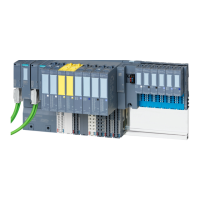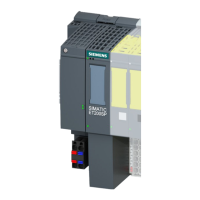Configuring
4-18 Application Module FM 458-1 DP - User Manual
A5E01078222-02 Edition 03.2009
AT- 'Setpoint.25.1'
the channel with the name setpoint transmits data to a slave
with the PROFIBUS address 25.
AR- 'RECEIVE.117.0'
the channel with the RECEIVE name receives data from a slave
with PROFIBUS address 117. As an exception, data are
transferred in the Intel format.
AR- 'Input.33.1R'
the channel with the name input receives data from a slave with
PROFIBUS address 33 as (second) master which reads data.
4.4.3 Equidistance and clock synchronism
For the FM 458-1 DP, equidistance and clock synchronism on
PROFIBUS DP is configured similar to that for a SIMATIC CPU (also
refer to the Manual "Configuring the SIMATIC hardware and configuring
connections with STEP 7", Chapter 3.12 "Setting bus cycles with the
same length for PROFIBUS sub networks").
For FM 458-1 DP, the user program is synchronized to the equidistant
PROFIBUS DP cycle in the following way:
Hardware configuration:
"Alarm tasks" tab of the FM 458-1 DP: Alarm source "PROFIBUS DP:
Receive data ready" - define for one of the interrupt tasks I1 - I8
Configure the user program using CFC in the defined interrupt task
I1-I8 (refer to the previous text)
If it is to be guaranteed that all data come from the same
PROFIBUS DP cycle, the channel mode 'Image' ('I' at the 'MOD'
connection) must be configured for the transmitter and receiver blocks in
this particular task.
The transmitter and receiver blocks of this task then form, for themselves,
a "consistency group". It only makes sense to use this on the FM 458-1
DP for communications via PROFIBUS DP in conjunction with the "clock
synchronism" functionality.
The following secondary conditions/limitations should be maintained for
the transmitter and receiver:
All of the transmitter/receiver FBs are configured in the same
task,
All transmitter/receiver FBs use the same communications
interface ("CTS" parameter), and
The same channel name is configured for all transmitter/receiver
FBs (specified at the "AT" or "AR" parameters).
This means that for each task and communications interface only one
"consistency group" is permitted in the transmit direction and one
"consistency group" in the receive direction.
If these conditions are not carefully observed, then an appropriate error
entry is made in the module diagnostics buffer.
Examples for
entries at the
address
connection
Introduction
Special features
FM 458-1 DP

